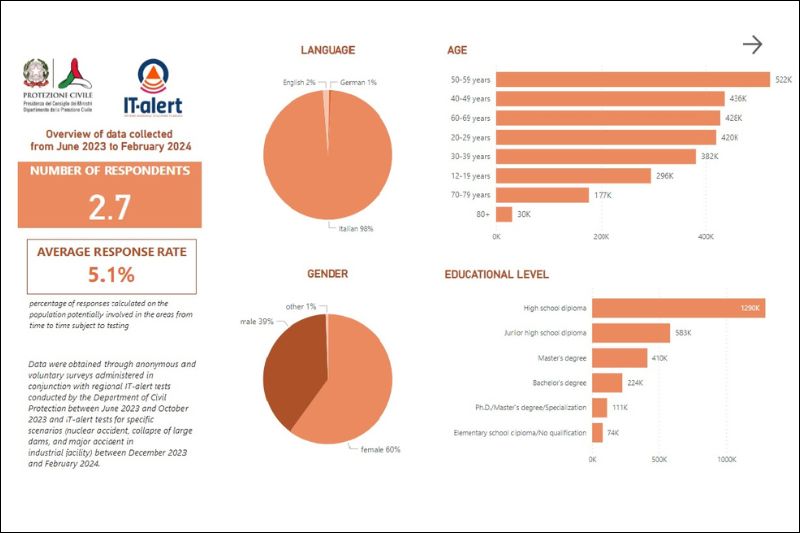Survey data dashboard - Tests from June 2023 to February 2024
Nearly 3 million surveys filled out by users during the testing activity

The dashboard shows data collected anonymously and voluntarily from surveys completed by users during IT-alert tests conducted from June 2023 to February 2024 in entire regions and limited portions of the territory on specific risk scenarios.
The sample is generated from users who agreed to participate in the activity by filling in the survey (self-selected sample) and giving feedback on the test of the warning system.
A total of 2,692,417 surveys were completed. Data analysis showed that more than 93 % of the respondents received the IT-alert message on their phones, and in most cases, they reported being in the test's target area. On average, there was only 1.6% overshooting, i.e., messages received outside the target area, but this percentage increased when testing in more limited areas.
About 97% of those who received the message reported that it was clear and understandable, and 89% reported that they immediately understood it was an institutional message. Another important finding concerned trust and a sense of security: for more than 91%, IT-alert is a significantly helpful tool.
About 90% reported that they had no problems interacting with the system, while the remaining 10% had trouble with messages disappearing instantly.
The most experienced emotion upon receipt of the message was the positive feeling of calm and tranquility (on average, about 30% of those who received the message). Still, respondents also experienced negative emotions such as anxiety, agitation, or fear (20%).
All these answers were cross-sectional and unrelated to the demographic characteristics of the respondents (gender, age, education title).
The findings represent, therefore, the view of a segment of the Italian population that received the information of the IT-alert experimentation and was inclined to fill in the questions in the survey. The average response rate was 5,1% of potentially involved citizens, which is a remarkable result. This figure, however, fails to allow generalizations about the entire Italian population.
Data are shown both globally, considering all stages of the experimentation, and by single testing date.
The Department of Civil Protection analyzed the data collected through the surveys in cooperation with CIMA Foundation and VIE - Valorizzazione Innovazione Empowerment S.r.l., a spin-off of the University of Genoa, which evaluated the efficacy of IT-alert message language.